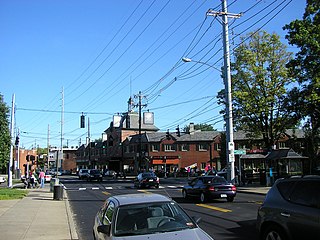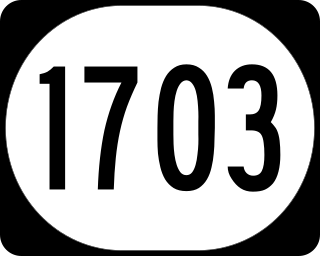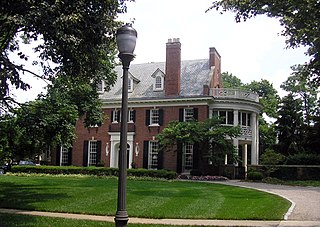
Louisville is the most populous city in the Commonwealth of Kentucky, sixth-most populous city in the Southeast, and the 27th-most-populous city in the United States. By land area, it is the country's 24th-largest city, although by population density, it is the 265th most dense city. Louisville is the historical county seat and, since 2003, the nominal seat of Jefferson County, on the Indiana border.

U.S. Route 150 is a 571-mile (919 km) long northwest–southeast United States highway, signed as east–west. It runs from U.S. Route 6 outside of Moline, Illinois, to U.S. Route 25 in Mount Vernon, Kentucky.

Deer Park is a neighborhood four miles southeast of downtown Louisville, Kentucky, USA. Most of the neighborhood was developed from 1890 through the 1920s as a streetcar suburb, with all but six of its 24 subdivisions being developed by 1917, and the last laid out by 1935, although some development west of Norris Place continued after World War II.

Tyler Park is a neighborhood three miles (5 km) southeast of downtown Louisville, Kentucky, USA. It is considered a part of a larger area of Louisville called The Highlands. Near the middle of the neighborhood is a city park of the same name, and many houses in the neighborhood feature park views. The neighborhood boundaries are St Louis Cemetery to the north, Bardstown Road to the east, Eastern Parkway to the south and Beargrass Creek to the west.

The Original Highlands is a historic neighborhood in the Highlands area of Louisville, Kentucky, United States.

Bonnycastle is a neighborhood four miles (6 km) southeast of downtown Louisville, Kentucky USA. It is considered a part of a larger area of Louisville called The Highlands. Its boundaries are Bardstown Road, Cherokee Road, Eastern Parkway and Speed Avenue.
Highlands–Douglass is a neighborhood five miles (8 km) southeast of downtown Louisville, Kentucky, United States. The neighborhood is bound by Bardstown Road, Speed Avenue, Taylorsville Road, and Cherokee Park. It is considered a part of a larger area of Louisville called The Highlands. It is often simply called Douglass.

This is a list of official neighborhoods in Louisville, Kentucky. Like many older American cities, Louisville has well-defined neighborhoods, many with well over a century of history as a neighborhood.
Hayfield-Dundee is a neighborhood in eastern Louisville, Kentucky. Its boundaries are Dundee Road, Emerson Avenue, Newburg Road, I-264, and Tremont Drive to the east. Prior to subdivision, much of the land had been part of the Hayfield Farm, owned by Dr. Charles Wilkens Short, a founding professor of the University of Louisville medical school.
Bon Air is a neighborhood in eastern Louisville, Kentucky, United States. Its boundaries are I-264 to the north, Bardstown Road to the west, Furman Boulevard to the east, and subdivisions to the south. The earliest residential development was the Wellingmoor subdivision in 1939, laid out by Ralph Drake. Growth picked up after World War II, but was broken up somewhat by the construction of the Watterson Expressway in the late 1940s.

The Highlands is an area in Louisville, Kentucky which contains a high density of nightclubs, eclectic businesses, and many upscale and fast food restaurants. It is centered along a three-mile (5 km) stretch of Bardstown Road and Baxter Avenue and is so named because it sits atop a ridge between the middle and south forks of Beargrass Creek. The commercial area extends from the intersection of Bardstown Road and Taylorsville Road/Trevillian Way in the south, to the intersection of Baxter Avenue and Lexington Road in the north, a length of 3.2 miles (5.1 km). A 1⁄2-mile (800 m) section of the nearby Barret Avenue also contains many similar businesses. The residential area is separated from other adjacent areas like Germantown and Crescent Hill by the south and north forks of Beargrass Creek. The middle fork runs through Cherokee Park, and the south fork divides Germantown from Tyler Park, after flowing past several cemeteries and undeveloped forests downstream from Joe Creason Park. Due to its large collection of night clubs and restaurants, it is locally known as "Restaurant Row".
Anshei Sfard is an Orthodox congregation and synagogue located at 2904 Bardstown Road, in Louisville, Kentucky, in the United States. Affiliated with the Orthodox Union, the synagogue offers Shabbat and Yom Tov services. Prayer services are conducted in Nusach Ashkenaz.

The Schuster Building is a mixed-use structure at the intersection of Bardstown Road and Eastern Parkway in the Highlands area of Louisville, Kentucky. Added to the National Register of Historic Places in 1980 as a "significant example" of Colonial Revival architecture as applied to commercial buildings, the Schuster building is one of Louisville's most prominent examples of that style.

Mid City Mall is a shopping mall in Louisville, Kentucky's Highlands area. While called a mall, and containing an enclosed shopping area, it has features atypical of suburban American malls, such as a comedy club, bar, grocery store and public library. A 1994 article in Louisville's Courier-Journal newspaper argued that the mall could be considered the "crossroads" of Louisville, and described it as being "only part shopping center, because it is also community center, courthouse square and retirement-village rec room."

The Bardstown Historic District, comprising the center of Bardstown, Kentucky, is a registered historic district on the National Register of Historic Places. Prominent architecture located within the district include the Cobblestone Path, Nelson County Jail, Old L & N Station, Old Talbott Tavern, and Spalding Hall, all individually on the National Register, and the historic old Nelson County Courthouse.
Bardstown Road is a major road in Louisville, Kentucky. It is known as "Restaurant Row", which comes from Bardstown Road's many restaurants, bakeries, and cafes, such as: "SuperChefs ", "Ramsi's Cafe on the World ", "Mark's Feed Store ", "Kizito Cookies ", and "Louisville Joe's Coffee Company ". It carries U.S. Route 31E and U.S. Route 150, from the intersection of Baxter Avenue (US 31E) and Broadway (US 150), southeast through Jefferson and Bullitt counties; in Spencer and Nelson counties, the road is named Louisville Road; that road becomes 3rd Street in Bardstown, where US 31E and US 150 split at the intersection with U.S. Route 62.

The Cherokee Triangle is a historic neighborhood in Louisville, Kentucky, USA, known for its large homes displaying an eclectic mix of architectural styles. Its boundaries are Bardstown Road to the southwest, Cherokee Park and Eastern Parkway to the southeast, and Cave Hill Cemetery to the north, and is considered a part of a larger area of Louisville called The Highlands. It is named for nearby Cherokee Park, a 409 acres (1.7 km2) park designed by Frederick Law Olmsted, the designer of New York's Central Park.

Kentucky Route 1703 is a north–south state highway extending 5.7 miles (9.2 km) across central Louisville, Kentucky. The southern terminus of the route is at Kentucky Route 2052. The northern terminus is at U.S. Route 31E/U.S. Route 150 at the junction of Bardstown Road, Baxter Avenue, and Highland Avenue. KY 1703 is named Newburg Road from KY 2052 to the Shady Lane intersection, where the road becomes Baxter Avenue for the duration of its route.

Humphrey-McMeekin House is considered one of the finest Colonial Revival houses in Louisville, Kentucky. It was designed and built in 1914–1915 as their private residence by newspaper editor Lewis Craig Humphrey (1875–1927) and his wife Eleanor Silliman Belknap Humphrey (1876–1964), both Louisville natives. The mansion was placed on the National Register of Historic Places in 1983.














